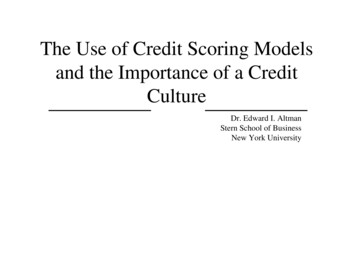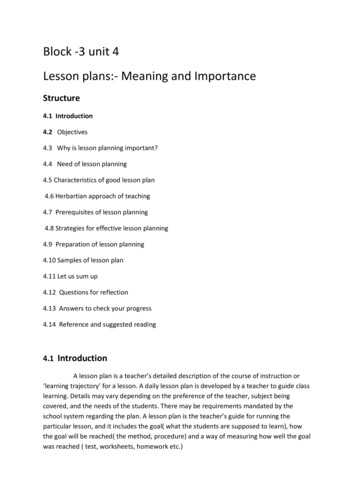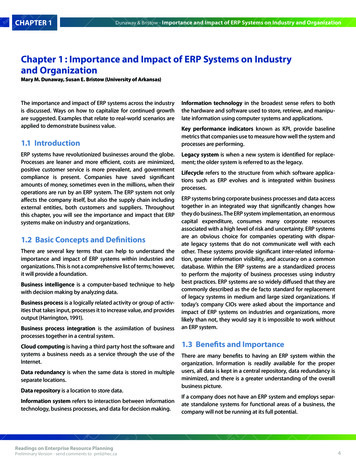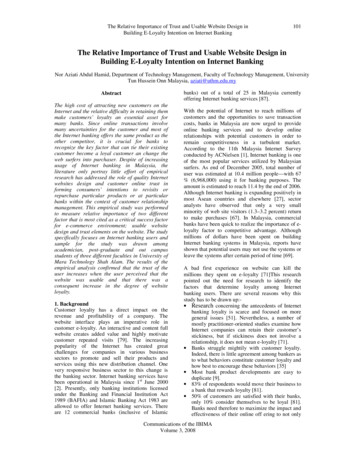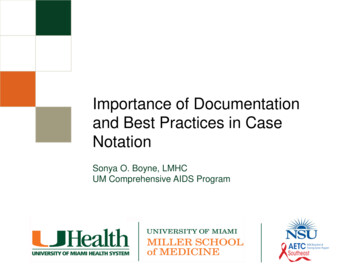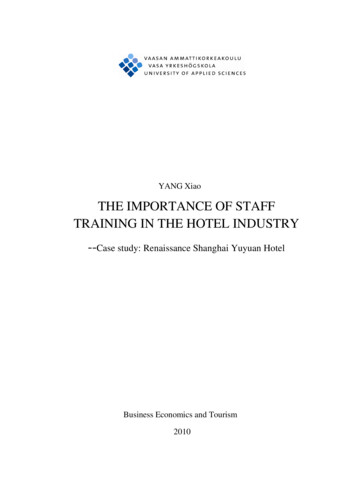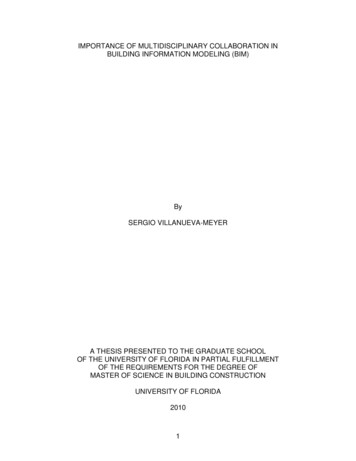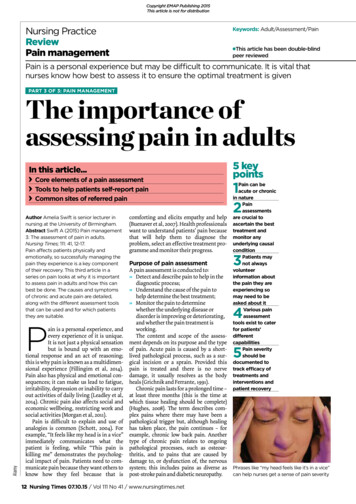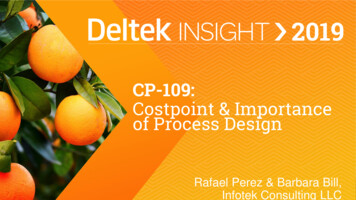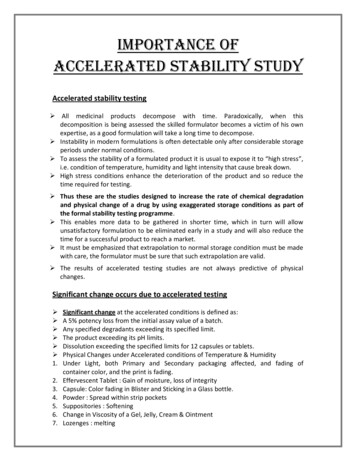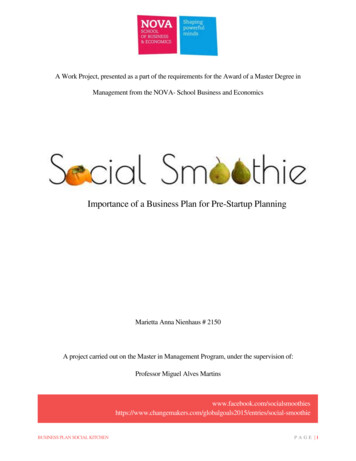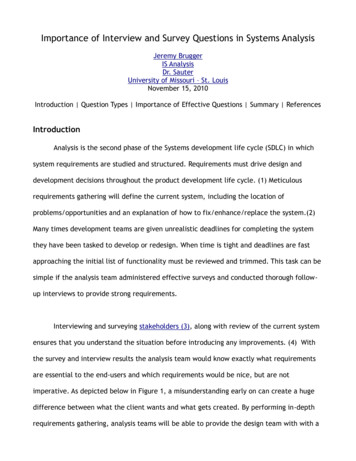
Transcription
Importance of Interview and Survey Questions in Systems AnalysisJeremy BruggerIS AnalysisDr. SauterUniversity of Missouri – St. LouisNovember 15, 2010Introduction Question Types Importance of Effective Questions Summary ReferencesIntroductionAnalysis is the second phase of the Systems development life cycle (SDLC) in whichsystem requirements are studied and structured. Requirements must drive design anddevelopment decisions throughout the product development life cycle. (1) Meticulousrequirements gathering will define the current system, including the location ofproblems/opportunities and an explanation of how to fix/enhance/replace the system.(2)Many times development teams are given unrealistic deadlines for completing the systemthey have been tasked to develop or redesign. When time is tight and deadlines are fastapproaching the initial list of functionality must be reviewed and trimmed. This task can besimple if the analysis team administered effective surveys and conducted thorough followup interviews to provide strong requirements.Interviewing and surveying stakeholders (3), along with review of the current systemensures that you understand the situation before introducing any improvements. (4) Withthe survey and interview results the analysis team would know exactly what requirementsare essential to the end-users and which requirements would be nice, but are notimperative. As depicted below in Figure 1, a misunderstanding early on can create a hugedifference between what the client wants and what gets created. By performing in-depthrequirements gathering, analysis teams will be able to provide the design team with with a
solid requirements document. A better understanding of how to word, ask and conductsurvey and interview questions will save time and increase the quality of the analysis. Thiswill in turn save time for the design and implementation phases of the systemsdevelopment life cycle (SDLC).Figure 1(20)Question TypesAn understanding of the types of questions and their correct uses is very important increating an effective survey and conducting a productive interview. The first type ofquestion is the closed-ended question (5). This question type usually consists of:
True/false or Yes/No Example: Can you give me more information? Multiple choice Example: Which of the following programs do you use the most? Rating a response on a scale (i.e.; good-bad, agree-disagree) Example: Rate the current system on a scale of 1 – 5. Ranking items in order of importance Example: Rank the following programs in order of relevance to your job.The closed-ended question is quick and requires little time to answer. Thesequestions are particularly useful for demographic-related questions. However,demographics questions should be asked at the end of the questionnaire in order not toaffect negatively the preparedness of respondents to answer questions due to the feeling oflosing anonymity, which could happen if they were asked those questions at the beginningof the questionnaire. (6) The downside of this question type is that they can be leading,hence irritating or threatening; they also discourage disclosure since the possible answersare predefined. (7)The next type of question and most important to systems analysis is the open-endedquestion (8). This question type allows for maximum flexibility in the interviewee'sresponse. Some examples of this question type: Describe your daily uses of the order entry system. What are the most useful features of the current order entry system? What features would you change?
Open-ended questions allow the analyst to get answers that are unanticipated andpotentially helpful in avoiding issues later in the process. These questions develop trust,are perceived as less threatening, allow for an unrestrained or free response. However,they can be time-consuming (7) and it can be difficult to develop general statements orassumptions. There is also the potential for the interviewee to ramble off into an uselessanswer.While sticking to the two question types above it is also important to avoid thefollowing question types:1. Leading Questions: You don't want to lead your respondents into answering a certain way based onthe wording of the questions.2. Loaded Questions: These types of questions work through emotionally charged items like words,stereotypes, etc. This too can push respondents towards a specific answerchoice.3. Built-in assumptions: Do not ask questions that assume the respondents are familiar with thespecifics of it. Include details or additional information if necessary.4. Jargon - Use simple language: Use words that are direct and familiar to the respondents. Try not to usejargon or technical concepts.5. Double Negatives or Double-Barreled Questions: Double-Barreled questions split them into more than one part, idea, ormeaning. The answer choice for each part might have separate meanings tothe ideas presented within the one question.(9)
Some of the types of questions above may unintentionally find their way into yourlist of questions. A good way to avoid this would peer review by a colleague or even test thesurvey out on a few colleagues to see if the responses fit the expected responses. (10)Taking a little time to refine your questions prior to the interview will increase the qualityof the answers you get and decrease the amount of time spent on this task.Questionnaire ng.comZapSurvey.comFormDesk.comImportance of Effective QuestionsThere are two ways a questionnaire might be terrible.1. It's uninteresting and difficult to answer, which is terrible from a respondent'spoint of view.2. It fails to collect useful data, which is terrible from a business point of view.(11)Effectively written and analyzed questions can make requirements gathering astreamlined process. If surveys are constructed in a way that allows you get the answersyou truly want then there will be fewer follow-up interviews needed. This sounds simple,however because no codified rules for question asking exists, it might appear that few, if
any basic principals exist to differentiate good from bad questions. (12) The same is truefor interviews, analysts may know what answers they need but that does not mean thatthey also know how to ask the questions to get to those answers. Just like people, no twosystems are alike so analysts need to approach them with a fresh, non-stereotypedperspective. If given a chance to talk freely, people appear to know a lot about what's goingon. (13) While there is no definably “right” or “wrong” way to ask questions, here are fivebasic characteristics of questions and answers that are fundamental to a good measurementprocess:1. Questions need to be consistently understood.2. Questions need to be consistently administered or communicated to respondents.3. What constitutes and adequate answer should be consistently communicated.4. Unless measuring knowledge is the goal of the question, all respondents should haveaccess to the information needed to answer the question accurately.5. Respondents must be willing to provide the answers called for in the question.(14)Figure 2(21)There is a history in survey research of thinking question design as an art, not ascience. (15)
Every analysis project will need a different mix of open- and closed-ended questions;this will depend on many factors, including the analyst familiarity with the system andcompany being analyzed. Qualitative data is your greatest opportunity to get actionableinformation from your survey. (16) However surveys do have potential downsides andpitfalls. Often, stakeholders are interviewed about their requirements or asked to writethem down, but this approach rarely uncovers the real requirements that reflect acustomer’s true interests or needs. Thorough analysis beyond the semantics of the surveyanswers or interview notes will uncover areas of ambiguity that will likely need claritydown the road. (17) To avoid the need for this extra analysis it is important to review yourquestions prior to interviewing or surveying the stakeholders. In event more questions ariseafter asking the questions, it is imperative that the analyst ask probing questions orschedule time to perform follow-up interviews to flush out any ambiguities. Makingassumptions at this stage could be costlyNot everything can be uncovered with surveys or interviews. If certain requirementsneed further clarity or if something from the survey or interviews didn't fully answer yourquestion then you may consider shadowing the user while they interact with the part of thesystem in question. This can be useful when: The user cannot articulate the answer to your question The user does not have time to interview The interviewer does not know what questions to ask(18)
SummaryLearning to construct quality questions is a skill that takes time and practice. Oncearmed with the knowledge of how to ask quality questions an analyst can make their jobeasier and the quality of that work much better. Your time and the time of your customeris on the line, so it makes sense to do all you can to ask questions that provide accurate,insightful responses. (19) Through the execution of effective surveys and interviews theanalysis phase of the SDLC can be maximized and save time in the design andimplementation phases as well.Figure 3(22)
References1. "Requirements Engineering for Product Development." IBM - Product LifecycleManagement. N.p., n.d. Web. 7 Nov. 2010. entsengineering.html?cn agus rtnlrepd20100514&cm k&csr google&cr engineering requirements&ct AGRAK616&ck engineering requirements&mkwid s2EGymWY3 5508017014 432dt32930&cmp 109HG .2. Hoffer, Jeffrey A., Joey F. George, and Joseph S. Valacich. "The Systems DevelopmentEnvironment." Modern systems analysis and design . 6th ed. Upper Saddle River, N.J.:Pearson Prentice Hall, 2011. Print.3. "Stakeholder - Definition and More from the Free Merriam-Webster Dictionary."Merriam-Webster Online. N.p., n.d. Web. 14 Nov. 2010. er .4. Robertson, Suzanne, and James Robertson. Mastering the requirements process . 2nded. Upper Saddle River, NJ : Addison-Wesley, 2006. Print.5. "closed question definition." BusinessDictionary.com - Online Business Dictionary.N.p., n.d. Web. 7 Nov. 2010. dquestion.html .6. Lietz, P. (2010). Research into questionnaire design. International Journal of MarketResearch, 52(2), 249-272. Retrieved from Business Source Premier database.7. Richardson Jr., John. "Open versus Closed Ended Questions." UCLA Department ofInformation Studies. N.p., n.d. Web. 7 Nov. 2010. penclosed.htm .8. "open ended question definition." BusinessDictionary.com - Online Business
Dictionary. N.p., n.d. Web. 7 Nov. 2010. ended-question.html .9. "SurveyMonkey Help Center - Tips for writing effective and relevant surveyquestions." SurveyMonkey Help Center - Support Home Page. N.p., n.d. Web. 7 Nov.2010. http://help.surveymonkey.com/app/answers/detail/a id/134/ stions. .10. Driscoll, Dana Lynn; Brizee, A. "Creating Good Interview and Survey Questions."Purdue Owl: Conducting Primary Research. N.p., 17 Apr. 2010. Web. 7 Nov. 2010. owl.english.purdue.edu/owl/resource/559/06/ .11. Kevin Jones. (2008, July). Got time to answer a few questions? B & T Weekly, 17.Retrieved November 14, 2010, from ABI/INFORM Trade & Industry. (Document ID:1512294071).12. Bradburn, Norman M., Seymour Sudman, and Brian Wansink. Asking questions: thedefinitive guide to questionnaire design : for market research, political polls, andsocial and health questionnaires. Rev. ed. San Francisco: Jossey-Bass, 2004. Print.13. Seidman, Irving. "Why Interview?." Interviewing as qualitative research: a guide forresearchers in education and the social sciences. 3rd ed. New York: Teachers CollegePress, 2006. 8. Print.14. Fowler, Floyd J. Improving survey questions: design and evaluation. ThousandsOaks, Calif.: Sage, 1995. 3-4. Print.15. Payne, S. (1951). The are of asking questions. Princeton, NY: Princeton UniversityPress.16. "Writing Effective Survey Questions." 360 Degree Feedback, Employee EngagementSurveys, Talent Management Solutions - CustomInsight. N.p., n.d. Web. 7 Nov. 2010.
rvey-questions.asp .17. Rupp, C.; , "Requirements and psychology," Software, IEEE , vol.19, no.3, pp.16-18,May/Jun 2002. doi: 10.1109/MS.2002.1003447. URL:http://ieeexplore.ieee.org/stamp/stamp.jsp?tp &arnumber 1003447&isnumber 2165418. Robertson, Suzanne, and James Robertson. Mastering the requirements process . 2nded. Upper Saddle River, NJ : Addison-Wesley, 2006. Print.19. Oriola, Steve . "8 Tips for Writing Effective Survey Questions." Email MarketingSolutions from Constant Contact. N.p., n.d. Web. 7 Nov. 2010. ts-tips/ht-2007-11os.jsp .20. Figure 1. "SDLC Image." blog.bksanders.com. N.p., 1 July 2010. Web. 7 Nov. 2010. -big.jpg .21. Figure 2. "Color Palette." survey.cvent.com. N.p., 1 June 2010. Web. 7 Nov. 2010. 7041b51fd8a w640.jpeg 22. Figure 3."Pocket Watch Image". rosettasister.files.wordpress.com. N.p., 1 Sept. 2008.Web. 7 Nov. 2010. ime is of the essence98142218std.jpg
survey and interview questions will save time and increase the quality of the analysis. This will in turn save time for the design and implementation phases of the systems development life cycle (SDLC). Figure 1 (20) Question Types An understanding of the types of questions and their correct uses is very important in creating an effective survey and conducting a productive interview. The first .
